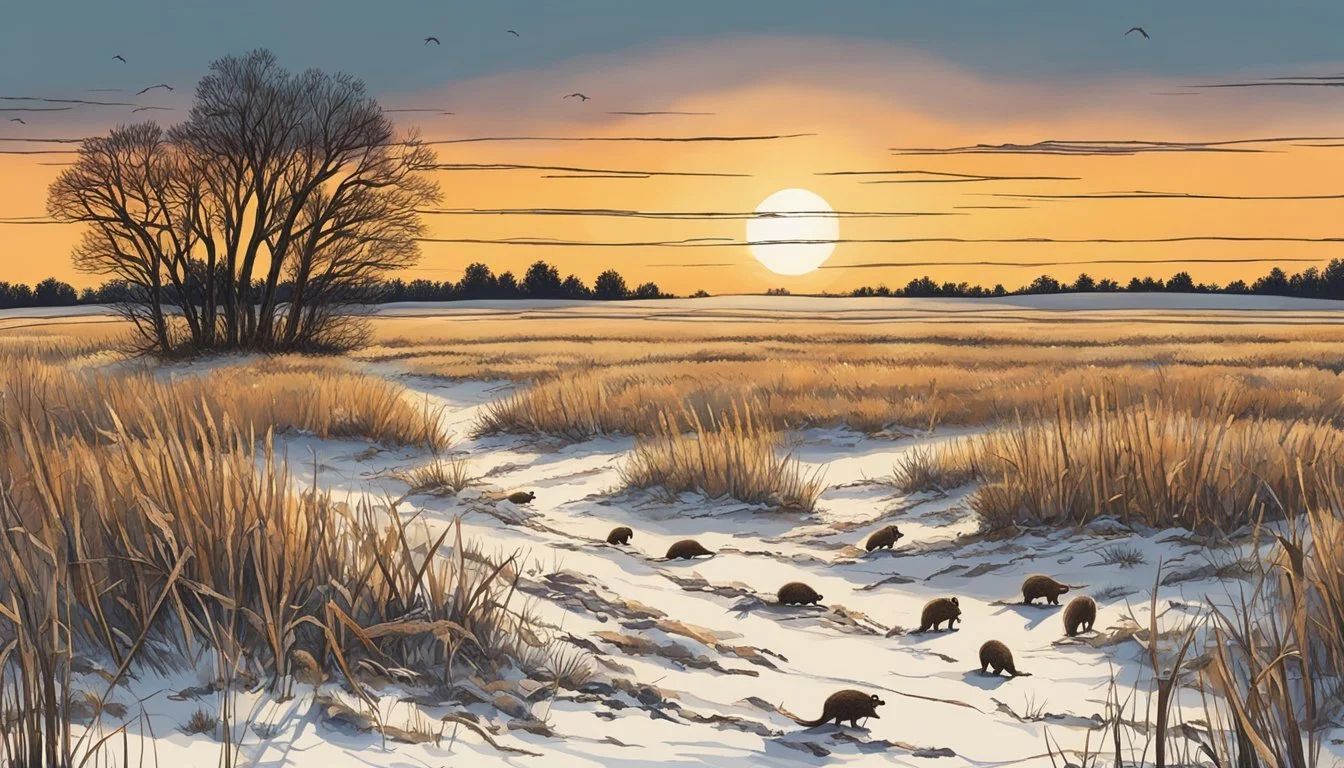Groundhog Hunting Seasons
Regulations and Best Practices
This Article is Part of Our Guide on Hunting Seasons for Over 70 Common Game Species
Groundhog hunting is an activity with deep roots in various rural traditions, often perceived as a means of wildlife management and population control. These small mammals, also known as woodchucks, are commonly found throughout North America, and their burrowing habits can affect soil structure and agriculture. Consequently, many states regulate groundhog hunting through designated seasons, permitting both traditional hunters and farmers to participate in managing the groundhog populations responsibly.
Specific hunting seasons for groundhogs are established to balance ecological needs with human interests. In states like Missouri, hunting seasons typically span from spring to late autumn, with dates varying from year to year. For example, the 2023 season in Missouri runs from May 8 to December 15, allowing hunters ample opportunity to hunt while also recognizing the animal's role in the ecosystem. Groundhog pelts, known for their dense fur, can also be possessed and sold year-round in some regions, providing an economic incentive alongside management purposes.
The regulations surrounding groundhog hunting are part of broader wildlife management strategies that aim to sustain healthy animal populations while minimizing conflicts with human activities. As with hunting any wild game, it's important for hunters to familiarize themselves with local laws, including permissible hunting methods and equipment, to ensure a lawful and ethical hunting experience. Given their widespread presence and the potential impact on land, grasping the nuances of groundhog hunting seasons is essential for those involved in rural and agricultural management.
Groundhog Basics
Understanding the fundamental aspects of groundhogs, including their biology and habits, is crucial for anyone interested in their hunting seasons.
Biology and Habitat
Groundhogs, also known as woodchucks, are robust rodents recognized by their thick fur and strong incisors. They typically have a grizzled brownish-gray coat and a short, bushy tail. Groundhogs make extensive use of burrows for shelter and hibernation. These structures are often located in areas with abundant vegetation which serves as their primary food source.
Ears and eyes: Positioned on the top of the head for heightened awareness.
Preferred habitats: Fields, pastures, and along fencelines or wooded edges.
Behavior Patterns
Groundhogs are predominantly diurnal, with activity peaking during the early morning and late afternoon hours. Their diet primarily consists of a variety of vegetation, including grasses, fruits, and crops. They are known for their hibernation patterns, with hibernating groundhogs retreating to their burrows for the winter season.
Activity cycle: Diurnal, with periods of feeding and burrow maintenance during daylight.
Seasonal patterns: Engage in hibernation during the winter months.
Hunting Preparations
Proper preparations are crucial for a successful and legal groundhog hunting experience. The section covers legalities, appropriate gear, as well as effective techniques.
Legal Requirements
Before setting out, hunters must secure a hunting license as required by local regulations. Hotspots for groundhog hunting usually have specific seasons and regulations, which may include:
Checking if groundhog hunting is permitted in the area
Adherence to bag limits
Compliance with hunting hours
Each state may have distinct requirements for obtaining a license; it's essential to consult with the state's wildlife agency or an official publication.
Gear and Firearms
For a productive hunt, having the right gear is non-negotiable. Essential items include:
Firearms: Bolt-action centerfires like the .223, .17 HMR, or .243 are preferred for their accuracy at long ranges.
Shotguns can be used, but rifles are usually the better choice due to their range and precision.
Scopes: A high-quality scope is imperative for spotting and targeting from a distance.
Bipods: For steadying rifles and minimizing recoil.
Ammunition selections often include polymer tip bullets for their ballistic efficiency and clean dispatching of the animal.
Hunting Techniques
Effective techniques can be the difference between going home empty-handed or with a successful catch.
Stay inconspicuous:
Use camouflage clothing to blend with the environment.
A head net might be useful to hide human facial contours.
Use terrain to advantage:
Set up in elevated areas for a good vantage point.
Position near soybean fields or hayfields where groundhogs are often spotted.
In every case, consideration for safe hunting practices and respect for the wildlife is of utmost priority.
Groundhog Hunting Strategies
Effective groundhog hunting requires a blend of patience and skill, focusing on the best times and locations, precise stalking and positioning, alongside sharp shooting practices to ensure success.
Best Times and Locations
Groundhogs, also known as woodchucks, are best hunted during the early morning or late afternoon hours when they are most active. They often reside in locations with ample food supply such as pastures, fields, and the perimeters of fence rows. Hunters should seek out groundhog burrows and dens, which are frequently found in open y.ards, as these are prime locations where groundhogs may be sighted.
Early Morning/Late Afternoon: Peak groundhog activity periods.
Habitat: Pastures, fields, fence rows.
Signs of Presence: Burrows and dens.
Stalking and Positioning
Stalking requires one to cautiously approach the hunting area to avoid alarming the groundhog. Hunters should utilize natural cover or terrain features for concealment. The challenge lies in silently positioning oneself within range for an effective shot, as groundhogs are vigilant and retreat quickly to their holes at the slightest hint of danger.
Approach: Use natural cover and move quietly.
Concealment: Stay low, use the terrain to your advantage.
Patience: Essential for closing in on a vigilant target.
Shooting and Accuracy
Accuracy is paramount when hunting groundhogs due to their small size and the distance at which they are often shot. A well-placed shot, ideally with a rifle suited for long-range accuracy, will ensure a humane and effective kill. The impact of a precise shot minimizes the possibility of the animal escaping back to its den, thus increasing the hunter's success rate.
Weapon Selection: High-velocity rifles with precision optics.
Shot Placement: Aim for the vitals to ensure a humane kill.
Practice: Regular target practice improves shooting proficiency.
Wildlife Management
Wildlife management is a critical aspect of conservation efforts, and it includes strategies to maintain balanced ecosystems. Groundhog hunting seasons are established as part of these efforts to regulate populations and to mitigate negative environmental impacts.
Population Control
Groundhog hunting is used as a tool for population control. These mammals can reproduce in large numbers, which may lead to overpopulation in certain areas. By instituting specific hunting seasons, wildlife agencies aim to keep the groundhog population at a sustainable level. This practice helps prevent issues such as agricultural damage and the overburdening of their habitats. For instance, in Missouri, groundhogs are classified as a game mammal, and hunting them during prescribed seasons aids in controlling their numbers.
Missouri: Prescribed hunting season to regulate numbers
Ohio: Considered nuisance species; regulated to mitigate damage
Environmental Impact
Groundhog hunting seasons also consider the broader environmental impact. Hunting can reduce the creation of large burrows that can affect soil stability and alter the landscape. Properly managed hunting seasons are enforced to ensure that the ecosystem remains balanced and that other species within the environment are not adversely affected. Regulations often provide guidelines on which methods of taking groundhogs are permitted, such as the use of cage-type traps in some regions.
Soil Stability: Minimizing large burrows through controlled hunting
Ecosystem Balance: Ensuring the sustainability of other species and habitats
After the Hunt
Upon the conclusion of a groundhog hunt, responsible handling of the game and its potential impact on local ecosystems are paramount considerations.
Handling the Harvest
Hunters must ensure that the harvest of groundhogs, also known as woodchucks or whistle pigs, is not wasted. They should respect the animal by making use of the fur and meat, where local regulations permit. Skinning and processing the meat should be done promptly to prevent spoilage and maintain the quality of the harvest. Dressed properly, groundhog fur can be used for various purposes, including warm clothing and other traditional crafts.
Local Ecosystem Contributions
Groundhog hunting can play a role in local conservation efforts by helping to control their population, especially in areas where they may cause significant damage to crops and property. These animals are known for their burrowing habits, which can interfere with agricultural machinery and even weaken the structural integrity of embankments. By managing their numbers through regulated hunting, individuals contribute to maintaining a balanced ecosystem, ensuring that groundhog populations remain at healthy levels and minimize conflict with human activities.
Relevant Regulations
Regulations governing groundhog hunting are set by state wildlife agencies and are essential for effective management and conservation. Adherence to these regulations, including seasonal restrictions and legal limitations, ensures sustainable hunting practices and wildlife populations.
Seasonal Restrictions
Various states establish specific open seasons for groundhog hunting. For instance, Missouri dictates that groundhog hunting is not allowed from May 8, 2023, to December 15, 2023. These restrictions can vary significantly across different states and should be confirmed with local wildlife agencies such as the Pennsylvania Game Commission.
Missouri: Season closed from May 8, 2023 - December 15, 2023.
Pennsylvania: Refer to the Pennsylvania Game Commission for current season dates.
Legal Limitations
Hunters must possess a valid hunting license to hunt groundhogs, with certain exceptions, such as landowners hunting on their property. The issuance and regulations of licenses fall under state management. Hunters should be aware of and adhere to any additional legal restrictions, such as limitations on the number of groundhogs that can be taken.
Hunting License: Generally required unless exempt (e.g., hunting on own property).
Bag Limits: Can vary by state; check local regulations.
Additional Wildlife
When discussing the hunting of groundhogs, it is also pertinent to consider other wildlife species that may either pose challenges or serve as potential game. Some animals are commonly labeled as pests due to their interactions with human habitats and activities, while predatory species play crucial roles in the ecosystem but may also be of interest to hunters during their respective seasons.
Common Pests
Crows and squirrels, both members of the squirrel family, frequently come into conflict with human interests. They can damage crops, gardens, and disrupt homes.
Crows:
Status: Oftentimes considered a nuisance due to their opportunistic behavior and impact on agriculture.
Management: Hunting seasons vary by state; some areas use non-lethal deterrents.
Classification: Small game
Management: Hunting seasons are established to manage populations.
Predatory Species
Predatory wildlife such as coyotes, foxes, bears, and bobcats contribute to the biodiversity of their habitats but can also be pursued by hunters as part of regulated small game hunting seasons.
Coyotes:
Behavior: Adaptive predators that can impact the populations of smaller mammals and livestock.
Hunting Season: Often open year-round to manage numbers and reduce conflicts.
Role: Control populations of rodents and other small game.
Hunting Season: Defined seasons, with variations across jurisdictions.
Significance: Large omnivores with significant roles within their ecosystems.
Hunting Season: Specific, short seasons due to conservation status and management goals.
Bobcats:
Habitat: Spread across diverse environments, preying on a variety of species.
Hunting Season: Limited permits and seasons to balance populations with ecosystem health.
Supplementary Information
When approaching groundhog hunting, it is critical to consider the role of hunting companions and diverse control methods. These factors can greatly influence the effectiveness and safety of hunting expeditions.
Hunting Companions
Hunters often incorporate dogs as tracking or retrieval aids due to their keen senses and agility. These canine companions are invaluable for flushing out groundhogs from their burrows, leading hunters to their hideouts. It's important to note that not all dog breeds are suitable for hunting groundhogs; terriers and dachshunds are among the preferred choices due to their size and hunting instincts.
Alternative Control Methods
Utilizing a variety of control methods can often yield better results than relying on hunting alone. For immediate groundhog deterrence, fencing is an effective non-lethal option. It should enclose the area with buried edges to prevent digging.
Method Purpose Considerations Scarecrows Deterrent Limited efficacy; groundhogs may habituate Flour Tracking Non-toxic; aids in revealing burrow entrances
For hunters, crossbows and shotguns are common tools. Crossbows enable quiet, precise shots, while shotguns are effective for close-range hunting.
Trapping is a method for non-lethal control, or to remove problem groundhogs. It is critical to check with local regulations regarding permissible trapping practices. Traps must be checked frequently to ensure humanely treatment of captured animals.







